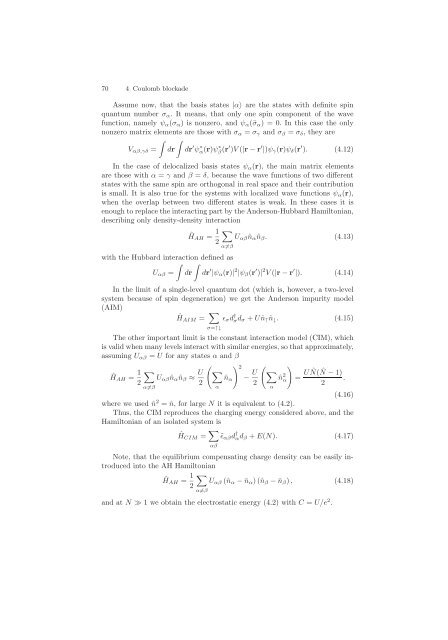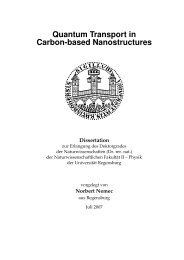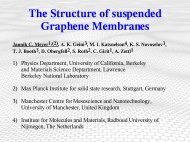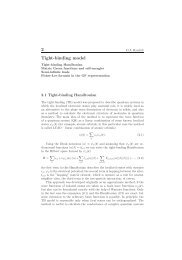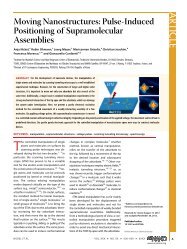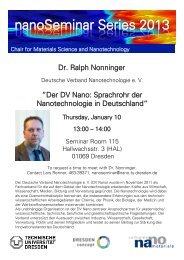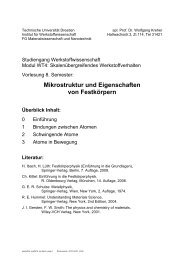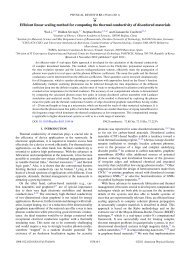4 Coulomb blockade
4 Coulomb blockade
4 Coulomb blockade
Create successful ePaper yourself
Turn your PDF publications into a flip-book with our unique Google optimized e-Paper software.
70 4 <strong>Coulomb</strong> <strong>blockade</strong><br />
Assume now, that the basis states |α〉 are the states with definite spin<br />
quantum number σα. It means, that only one spin component of the wave<br />
function, namely ψα(σα) is nonzero, and ψα(¯σα) = 0. In this case the only<br />
nonzero matrix elements are those with σα = σγ and σβ = σδ, theyare<br />
<br />
Vαβ,γδ = dr dr ′ ψ ∗ α(r)ψ ∗ β(r ′ )V (|r − r ′ |)ψγ(r)ψδ(r ′ ). (4.12)<br />
In the case of delocalized basis states ψα(r), the main matrix elements<br />
are those with α = γ and β = δ, because the wave functions of two different<br />
states with the same spin are orthogonal in real space and their contribution<br />
is small. It is also true for the systems with localized wave functions ψα(r),<br />
when the overlap between two different states is weak. In these cases it is<br />
enough to replace the interacting part by the Anderson-Hubbard Hamiltonian,<br />
describing only density-density interaction<br />
ˆHAH = 1 <br />
Uαβ ˆnαˆnβ. (4.13)<br />
2<br />
α=β<br />
with the Hubbard interaction defined as<br />
<br />
Uαβ = dr<br />
dr ′ |ψα(r)| 2 |ψβ(r ′ )| 2 V (|r − r ′ |). (4.14)<br />
In the limit of a single-level quantum dot (which is, however, a two-level<br />
system because of spin degeneration) we get the Anderson impurity model<br />
(AIM)<br />
ˆHAIM = <br />
σ=↑↓<br />
ɛσd † σdσ + U ˆn↑ˆn↓. (4.15)<br />
The other important limit is the constant interaction model (CIM), which<br />
is valid when many levels interact with similar energies, so that approximately,<br />
assuming Uαβ = U for any states α and β<br />
ˆHAH = 1 <br />
Uαβ ˆnαˆnβ ≈<br />
2<br />
α=β<br />
U<br />
2 <br />
ˆnα<br />
2<br />
α<br />
− U<br />
<br />
<br />
ˆn<br />
2<br />
α<br />
2 <br />
α<br />
= U ˆ N( ˆ N − 1)<br />
.<br />
2<br />
(4.16)<br />
where we used ˆn 2 =ˆn, forlargeNit is equivalent to (4.2).<br />
Thus, the CIM reproduces the charging energy considered above, and the<br />
Hamiltonian of an isolated system is<br />
ˆHCIM = <br />
αβ<br />
˜ɛαβd † αdβ + E(N). (4.17)<br />
Note, that the equilibrium compensating charge density can be easily introduced<br />
into the AH Hamiltonian<br />
ˆHAH = 1 <br />
Uαβ (ˆnα − ¯nα)(ˆnβ − ¯nβ) , (4.18)<br />
2<br />
α=β<br />
and at N ≫ 1 we obtain the electrostatic energy (4.2) with C = U/e 2 .


